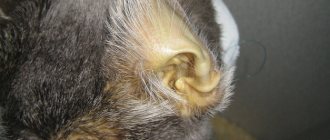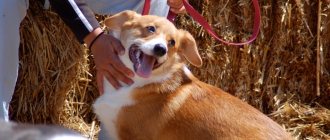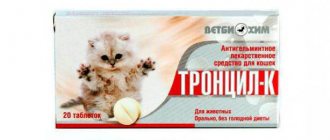Lungworms in cats: life stage of roundworms
There are not so many “purebred” pulmonary parasites in our country: basically, they are found en masse in regions with hotter and more humid climates. But in our area there are often cases of ascariasis, i.e. helminthic diseases caused by parasitic nematodes. In 90% of cases they are mistaken for “pulmonary” worms.
It's all about the peculiarities of the life cycle of parasitic roundworms. Their larvae, once in the digestive tract of the final host, do not remain there for a long time. Young parasites gnaw through the intestinal walls, reaching local blood vessels. The larva, having broken through the wall of the latter, ends up in the general bloodstream. Its target is the pulmonary alveoli (however, along the way, the larvae often end up in completely different organs and tissues).
The larva spends about three weeks in the lungs. At this time, the parasite actively feeds on the pulmonary epithelium and blood, develops and grows. When the time comes, the worm’s body begins to secrete caustic and “burning” substances that irritate the delicate lung tissue. As a result, the animal develops a severe cough. Together with the expectorated mucus, the larvae again enter the animal’s gastrointestinal tract, and this time they remain there for growth and development.
But two or three weeks spent by growing parasites in the lungs does not have the best effect on the animal’s health. In particular, young pets often develop severe bronchitis or even pneumonia after this.
But! Despite all of the above, ordinary parasitic nematodes do not live permanently in the lungs and bronchi, since for them this time is a short stage of development.
At the same time, there are “full-fledged” lungworms that constantly live in the lumen of the respiratory system.
How does infection occur?
Helminths can enter an animal's body in various ways. Dogs and cats can ingest them in street dust. This can happen in the yard or in the apartment. Worm eggs enter homes on a person's shoes. A cow can drink water from a pond in which helminths live. In the intestine, larvae emerge from the swallowed eggs, which quickly become sexually mature individuals and begin to multiply quickly.
From the intestines, small individuals of the larval form leak into the bloodstream, from where they are carried into the lungs. Parasites that end up in the trachea and bronchi cause mucus to accumulate inside the respiratory organs. It is this that causes difficulty in breathing and shortness of breath.
That is why, by promptly paying attention to cough, you can prevent damage to the internal organs of cats, dogs and cattle.
This is an extremely common type of parasite. Among them there are even “heart” worms that live in the aorta, pulmonary arteries and heart cavities. Fortunately, such “exotics” are extremely rare in our country. Animals usually become infected with Toxocara. The most common parasite is Toxocara cati. They are extremely invasive, widespread in the external environment, and pose a certain threat to the health of not only cats, but even humans.
The length of adult individuals can reach 10 cm, but they are usually more modest and rarely grow more than 4-5 cm. The color of tocoscaras varies from brownish to whitish-yellow, and they can occasionally be seen in feces. So, in cases where you see some “spaghetti” in your pet’s litter box, this most likely indicates an infestation of roundworms.
Experts believe that when infected with parasitic nematodes, cats may exhibit the following symptoms:
- Animals (especially kittens) become like a pear: the stomach is constantly swollen, as if the pet has just eaten a hearty meal, but at the same time signs of severe exhaustion are constantly developing. The fur of pot-bellied pets becomes stiff, the skin loses its elasticity and is noticeably dry to the touch. If you stroke a cat's chest, protruding ribs will “scream” into your hand.
- Frequent loose stools or diarrhea, interspersed with cases of “silent” constipation.
- Apathy, sickly appearance, the previously playful cat tries to spend as much time as possible huddled in a corner somewhere.
Migrating nematode larvae manifest themselves no less clearly. They, having hatched in the intestine, pierce its wall, reaching the nearest blood vessel, and then, once in the general bloodstream, they go to the lungs (pulmonary forms). There the larvae grow and develop for a couple of weeks, intensively feeding on the tissues of the long-suffering lungs.
But infections are much more prosaic - the animal simply swallows the parasite eggs along with contaminated food or water. In addition, some parasitic nematodes use intermediate hosts. If your cat has a fondness for grasshoppers or other “little things”, constantly eating them, he is also at increased risk.
You just need to remember that processing alone is usually not enough. It must be repeated after 10-14 days. This is how long it takes for the migrating larvae to re-arrive in the intestines from the lungs. And yes, most anthelmintic drugs have no effect on such forms, so it is almost impossible to destroy “dormant” worms located in the mammary glands or other internal organs.
Hookworm
This particular disease should be described separately, since the symptoms it causes are very severe. Often the pathology even leads to death. Its risk increases markedly when kittens and initially weakened ones are sick, as well as old animals whose bodies already have a reduced immune status.
In most cases, nematodes of the species Ancylostoma braziliense are found in cats. A distinctive feature of these worms is “invisibility”. They are so small that you cannot see the parasites with the naked eye. More precisely, their length even in adulthood is no more than 1/8 cm, and their bodies are very thin. You can still see them, but to do this you need to look closely at cat feces for a very long time and very carefully, and only a few breeders will do this.
But hookworms are especially unpleasant because of their ability to infect people. Small larvae, when a person walks on the ground with bare feet, pierce the skin of the feet (and, thanks to the shoes of modern people, it is soft), enter the bloodstream and are sent towards the organs of the gastrointestinal tract. And these worms, already in the intestines, feed not on semi-digested food masses or mucous membranes (like “decent” helminths), but on blood.
Parasitologists believe that the body of an adult and physically strong cat resists the action of parasites well, but this does not apply to kittens and weakened pets:
- Blood often appears in the feces.
- The cat constantly has loose stools, and nothing is wrong with her diet.
- When palpating the abdomen, the pet shows signs of anxiety, as this action causes him pain.
- The animal becomes weaker, the visible mucous membranes turn pale due to chronic anemia, the eyes become sunken due to general dehydration and extreme exhaustion.
We suggest you read: Why does a cat's belly hang?
The route of infection is the same as in humans. From infected feces that have entered the external environment, water and wind “receive” thousands of eggs. The larvae hatch from them and wait in the soil. They stick to the fur and are subsequently swallowed by the animal, or they can become “independent”, entering first the blood (through the paw pads) and then into the digestive tract.
“dormant” larvae that find themselves in the mammary glands wake up and gnaw their way straight to the milk ducts. Within two to three weeks, young parasites become adults and begin to lay eggs. As we have already mentioned, during treatment, the administration of anthelmintic drugs must be repeated from two to five times.
And there is one more curious type of parasitic nematode that cat owners need to know about. Pathogens known as Physaloptera or Ollanulus tricuspisr cause physalopterosis. Animals become infected by eating intermediate hosts of the parasite, which can be grasshoppers, chafers and other “fleshy” insects.
How do you even know that a cat has such unusual “guests”? They, unlike other parasitic roundworms, can be regularly seen in cat feces from time to time. The worms are not very impressive in length (up to 2.5 cm), but they are painted whitish in color, and therefore are clearly visible in the thickness of the feces. Symptoms of worm infestation in cats include the following:
- Vomiting appears first. At first it is quite moderate, but soon her attacks become regular and very strong. A sick cat can simply be “rinsed.”
- Fast weight loss. Due to vomiting and severe damage to the stomach, the mucous membrane of which the parasites feed on, digestion is disrupted and the pet does not receive the proper amount of energy and nutrients.
- The cat becomes inactive, prefers to sit more often and not move.
Note that Ollulanus tricuspis is quite rare in our country, but outbreaks of the disease are common among animals transported (often illegally and without veterinary passports) from other countries. Physaloptera infestations are more common, and result from a cat either eating the vomit of another infected cat or eating the host to the parasite.
“Real” lungworms in cats
Today, biologists and veterinarians believe that three types of lungworms can be found in these animals:
- Aelurostrongylus abstrusus (causes a disease called elurostrongylosis). The most “feline” parasite, since it is the one that can most often be found in representatives of the cat family. Its prevalence is largely due to the huge number of intermediate hosts: the larvae of the parasite can be found in the body of a variety of “small things”, ranging from amphibians and reptiles to birds. It is not surprising that veterinarians identify cases of infection not only here, but throughout the world. Thus, studies conducted by German veterinarians in 1997 showed that approximately 21% of all rural cats are carriers. Interestingly, many animals either do not have any special clinical signs, or they are too vague and weak for animal owners to contact a veterinarian.
- Capillaria aerophilia. Unlike both related species, these worms do not require intermediate hosts at all. It is enough for a cat to simply swallow the eggs of the parasite. Even 10-15 years ago, it was believed that this type of worm was found exclusively in North America, but the processes of globalization were not in vain: there is already information about infestations in our country. However, many biologists and parasitologists believe that globalization has nothing to do with it. It is very likely that the parasite entered the territory of the former USSR along with raccoon dogs imported from America.
- Paragonimus kellicotti. Least likely option. The fact is that the parasite is specific to the canine family, but occasionally it can be found in the body of cats (but this does not happen often). In addition, only (!) freshwater mollusks, and sometimes crayfish, act as intermediate hosts, which makes the prospect of infection of a domestic cat quite unlikely. In addition, parasite eggs (in huge quantities) are usually found when examining the feces of wild raccoons and raccoon dogs. It was with them that the worm entered the territory of our country, where it had never been encountered before.
All parasites of this type have one thing in common: all these worms need an intermediate host to develop. Infection occurs only when it is eaten by a cat. Mollusks, including land snails and even slugs, usually act as “incubators.” Of course, cats rarely eat such “tasty” game, but the same snails may well be eaten by rats or mice. And cats hunt small rodents, and they do it very actively!
Cat coughs: causes and treatment
In fact, you can independently identify this disease in an animal without much difficulty. The main thing is to carefully monitor his behavior, actions and habits. Helminthiasis has very obvious and non-standard symptoms, which, of course, benefits owners who want to help their pet.
- cough;
- vomit;
- itching in the anus (the animal pays too much attention to this area of the body, constantly touches and scratches it);
- bloating;
- strange inclusions (including blood) in excrement;
- digestive problems;
- severe baldness, hair loss and discoloration;
- pus from the eyes, ears, nose;
- standard symptoms of intoxication;
- weakness, drowsiness, apathy.
This entire huge list of symptoms literally calls on owners to quickly help their pet and rid it of uninvited guests. Even if at least 1 symptom is present, you need to sound the alarm, since this is clearly unhealthy behavior for a cat.
Watch a video on how to determine if a cat has worms.
In an amicable way, of course, you need to take the animal to a veterinarian, who can correctly determine the type of helminth and prescribe the appropriate medications. A competent specialist is able to select such treatment that all parasites will leave the body in just 1 session. If it is not possible to visit a doctor, then we go to the veterinary store ourselves. There we purchase an anthelmintic drug (as a rule, they are general purpose and are suitable for removing any parasite) and use it on the cat according to the instructions. It could be pills, it could be drops on the withers - it doesn’t matter here. The main thing is to choose a quality product and not harm your pet.
As for the use of human drugs on animals, we immediately reject this idea and forget about it once and for all. Under no circumstances should human medications, especially anthelmintics, be used on domestic or wild animals. The consequences can be terrible; you should not risk the health or even the life of your pet.
If a cat sneezes and coughs, this does not mean that he has roundworms. There are many reasons why an animal is unwell. Other causes of health problems cannot be ruled out:
foreign object in the respiratory tract;
The possibility of a cold cannot be ruled out. Even pets are susceptible to viruses and bacteria. If we suspect a cold, we take the animal to the doctor.
Unfortunately, with age, the heart muscle begins to weaken; in obese individuals, the heart increases in size due to excess adipose tissue on it. But this is far from the point. When the heart becomes larger, it begins to put pressure on the respiratory organs adjacent to it. This causes a severe cough.
Do you suspect your cat of being infected with worms? Leave your message in the comments! And also watch a video about the treatment of worms in cats.
When a pet begins to have health problems, we usually think that these are some age-related changes or that the pet just got sick with a common cold. But few people think about the fact that maybe the cat is coughing from worms. It is extremely easy even for a pet to pick up helminth eggs and then live with them for a long period of time, because it is extremely difficult for a person to determine the presence of roundworms by some external parameters. But if you pay attention to the cough, this disease can be detected even in the early stages.
Development cycle, features
It is interesting that the eggs of the parasite are released from the cat’s body not with expectorated bronchial sputum, which would be quite logical, but with feces. The eggs get there along with swallowed sputum. It is curious that they, once released into the external environment along with sputum (if the cat has not swallowed it), do not pose a danger. This is explained by the fact that the shell of the eggs must be “treated” with the digestive secretions of the animal.
When feces dry out and are spread across the land by wind and water, they can be eaten by land (or aquatic) mollusks, as well as other living creatures that can act as an intermediate host for helminths. In their body, the larvae mature to the required stage. If a cat simply eats the eggs of the parasite, infection will not occur (this, of course, does not apply to Capillaria aerophilia).
Once in the digestive tract, the larva breaks through the intestinal walls and, gnawing its way through the lining of the blood or lymphatic vessels, reaches the lungs along with the blood or lymph flow. Note that the clinical picture does not develop immediately: the subclinical form lasts up to six months. It is believed that the duration of the clinical form can reach two years. After this period, if the animal is not infected again, self-healing occurs due to the death of parasites due to age-related reasons.
Types of cough and its signs
Coughs are classified according to several criteria: frequency, strength, presence of sputum, duration and timbre.
The cough may be:
- cough may appear only in the morning or evening or bother the animal throughout the day;
- dry with a small amount of sputum and wet (wet) when a large amount of secretion is produced;
- painful during acute processes (laryngitis, tracheitis, etc.) and little painful or painless during chronic respiratory diseases;
- muffled (silent) or ringing, barking, hoarse (timbre);
- Based on strength, it is customary to distinguish between a hysterical cough and a debilitating one, a weak (light cough) and a strong one;
- The duration of the cough can be acute (lasting up to 2 weeks) and chronic.
All these signs allow the veterinarian to determine the likely cause of the animal’s illness. If your animal regularly suffers from coughing, you should definitely show it to a doctor. It is not difficult to determine that your pet is coughing. The animal takes a characteristic pose, trying to suppress the cough reflex. The cat takes a semi-crouching or standing position, with its paws spread wide, its back slightly arched and its head stretched forward. His stomach is pulled in and a characteristic hoarse sound comes from his throat. Sometimes the cough is accompanied by gagging.
Clinical signs of the disease
Considering the characteristics and importance of the organs in which these worms live, it is easy to predict the clinical signs of infection with them:
- The main symptom is a fairly quickly occurring, severe cough. Initially, it is dry, tense, even “barking”; metallic notes can be heard in it. All this indicates a serious damage to the bronchial system. But soon the inflammation becomes chronic, and the abundant exudate “eases” the cough, which becomes wet. You can clearly hear a sick cat coughing up clots of sputum (which is full of parasite eggs).
- The younger the animal, the more severely it suffers the infection. In severe cases, respiratory failure begins to appear two to three weeks after the first symptoms appear. The pet breathes heavily and wheezes, often breathing becomes shallow, fast and “selective”. All this is accompanied by gurgling wheezing in the chest, which can easily be heard without resorting to a phonendoscope.
- A characteristic sign of the disease is a sharp deterioration in the quality of the coat. The hair becomes very hard and brittle and breaks easily.
- Since the cat’s immune system is greatly weakened at this time , the further development of the inflammatory process occurs quickly, often ending (at best) in severe bronchitis, but more often this all leads to pneumonia. Young cats can “burn out” from it in just a couple of days.
- In the same cases, the general body temperature rises , the animal’s condition deteriorates sharply, the cat refuses food and, in the most severe cases, even water.
Simply put, all the symptoms of the disease clearly indicate “ordinary” lung pathologies. Suspecting that a coughing and choking cat is suffering from worms is not an easy task, and even experienced veterinarians do not immediately realize this (especially if there have been no such cases in a particular area).
It is precisely due to the circumstances described above that no one will give you a diagnosis “by eye”. To determine the root causes of what is happening to the cat, a high-quality examination is required, as well as sputum tests, bronchoscopy, etc. It is quite possible that parasites have nothing to do with it at all, and the cat has “ordinary” pneumonia of infectious origin.
If the animal was not given help, but it still survived, then self-healing may occur over time. This is due to the fact that worms can live in a cat’s body for about two years, after which they die. But in practice this rarely happens. Of course, “veterans” die, but there is no guarantee that the cat will not become infected again.
Anthelminthic treatment
Many patients believe that helminths settle exclusively in the human intestines. But in reality, this is not the case at all. Parasites can live in the liver, pancreas, bile ducts, and lungs - so coughing from worms is a fairly common symptom.
A dry cough from helminths indicates that parasites are actively moving in the human body, so it is necessary to take measures. Of course, coughing attacks are unpleasant and painful, but this is a sign that the human body is “asking for help.”
Cough from worms in the vast majority of cases appears in childhood. And it is often mistaken for respiratory and viral diseases. That is why it is necessary to establish the exact causes of this condition so as not to stuff the patient with useless pills.
As medical practice shows, cough and worms have a clear relationship. It is necessary to consider which helminths can provoke coughing attacks, what other symptoms complement the clinical picture?
Many people find it strange that coughs and worms can be interrelated, believing it to be unrealistic and sometimes even absurd. However, for many helminth infections caused by various types of helminths, cough is a characteristic symptom.
We suggest you read: How to treat viral rhinotracheitis in cats
And there is absolutely nothing unusual in this circumstance. There are two reasons why adults may experience cough due to parasites. The first of them is that helminths have chosen the human lungs as their home. The second says that parasite larvae “travel” through the respiratory tract.
Undoubtedly, parasites predominantly settle in the human intestines. But in the process of their active reproduction, they, along with the bloodstream, are transferred to other internal organs, settling in the lungs, bronchi and trachea.
Having settled in the respiratory tract, the worms become a mechanical obstacle to the full passage of air, resulting in difficulty breathing, coughing attacks and other symptoms.
On their way, helminths feed on mucous and blood components in the respiratory tract, and in response they release toxic substances, products of their vital activity, as a result, intoxication develops with allergic and inflammatory processes.
Some of the worm larvae come out during a coughing attack, passing into a latent state, but the other part, along with saliva, again moves into the intestines, where the larvae are already transformed into adults.
Ignoring coughing attacks due to worms can lead to the following consequences:
- Impaired functionality of the respiratory system.
- Damage to lung tissue with internal bleeding.
- Severe pulmonary diseases.
- Pneumonia.
- Bronchial asthma.
At the early stage of parasite infection, the patient only experiences a severe, nonproductive cough. Over time, sputum appears, but when blood is present in the bronchial mucus, this indicates that helminthiasis has become chronic, so surgical treatment is necessary.
Have you noticed that your cat or dog has a cough? Is your dog suffering from asthma attacks? Cows can also suffer from this symptom. What causes it?
Cough is a physiological reflex that occurs when a signal is transmitted from certain receptors to the center of the brain. This property is not unique to humans, but also occurs in dogs and even cats. Many cattle breeders note that cows can also cough. This symptomatology does not develop independently, but is a manifestation of some pathology. Most often this occurs when the functioning of the respiratory system is impaired.
There are several types of worms that live in the respiratory area of domestic animals. Among the most frequently encountered parasites are Aelurostrongylus abstrusus and Capillaria aerophila. They are most often diagnosed in cats. The dog can also become infected. Worms, as a rule, reach no more than 1 cm in size.
Cattle may become infected at watering places
Lungworms are found primarily in cats and dogs that roam outside unattended. Cows can become infected on pasture if there are poor quality watering places.
Antihelminthic therapy consists of:
- destruction and removal of parasitic worms from the cat’s body;
- relief of associated symptoms;
- elimination of intoxication.
Anthelmintics are available in several forms:
- suspensions;
- pills;
- pastes;
- drops on the withers.
- most modern remedies are given once in the first half of the day without a fasting diet;
- in case of severe infection, it is recommended to take the product after 10-14 days (in accordance with the instructions for the drug);
- deworming must be carried out after treatment against fleas, lice eaters and other skin blood-sucking parasites;
- medications for worms are given to the cat no later than 10 days before the scheduled date of vaccination;
- anthelmintic drugs for pregnant cats are usually prescribed no later than 3 weeks before birth, and for nursing cats - no earlier than 3 weeks after birth;
- there are no drugs approved for very young kittens (less than 3 weeks of age);
- it is forbidden to increase the dosage established by the instructions;
- Antiparasitic drugs are not given to sick and weakened animals;
- Also, usually at the same time as taking the medicine for worms, the cat is given any general strengthening agent, and also after 4-6 hours, any adsorbent agent is given to minimize the effect of intoxication on the body from the death of helminths.
Many worms in cats are transmitted to humans, therefore, if worms are detected in a cat, it is recommended to carry out preventive deworming for all family members who have had contact with the pet.
It is forbidden to give human medications to cats, therefore, only a veterinarian can determine how to treat cats for worms. Moreover, the range of veterinary remedies for parasites is huge!
- Causes of infection and types of worms
- Signs of parasites in cats
- How to diagnose and treat
- Video
Helminthiasis is the most common disease of domestic animals, including cats. Worms are dangerous because some of them can be transmitted from an infected animal to humans. Even if the pet does not go outside at all, there is a high risk of contracting a helminthic infestation through dirt carried on shoes or clothes.
Owners who decide to get a small kitten or an adult cat mistakenly believe that such a creature requires only minimal care if you do not let it out of the house. Under certain conditions, parasite eggs can enter the body of even the most well-groomed pets who live in prosperous conditions.
When the first signs of helminthiasis appear, it is very important to find out the form of helminthic infestation, since incorrectly selected treatment can lead to serious complications or even the death of the cat. Only a veterinarian can determine what type of helminth has entered the body after a thorough medical examination of the animal.
The following forms of parasites may occur in domestic cats:
- roundworms;
- tapeworms;
- flukes.
Helminths contribute to the development of various diseases and often affect the organs and tissues of a pet. Sick kittens and adult cats can become infected with different types of helminths that colonize the intestines, heart, lungs, gall bladder or liver.
Parasites enter the body in different ways, through:
- consumption of freshwater fish;
- raw meat;
- mice;
- contact with a sick animal;
- contaminated mother's milk.
The most common cat worm infestation is nematodes, which can reach a length of up to 10 centimeters. Of the roundworms, the most common are hookworms, which are up to 3 cm long. They settle in the small intestine and are dangerous for kittens because they often lead to anemia and can cause death.
Often the disease occurs secretly and does not cause alarming symptoms in the pet owner. Helminthic infestation can occur in acute and chronic phases. You can suspect the presence of helminths based on the following signs:
- loss of appetite;
- dull coat;
- lacrimation;
- lethargy;
- itching in the anus;
- pallor of mucous membranes;
- liver enlargement;
- convulsions or paresis.
If you independently examine a cat, you can sometimes find whole worms or their fragments in the anal area and in feces. Roundworms usually cause your pet to have an unnatural increase in appetite, lethargy, severe diarrhea and frequent vomiting. When infected with nematodes, blood may appear in the stool, continuous diarrhea and severe stomach pain. Flukes cause foamy vomiting, fever, diarrhea and cough.
Symptoms of toxoplasmosis in a cat are similar to poisoning or a cold and include trembling muscles, nasal discharge, sneezing, weakness and refusal to eat. Heartworms usually cause no symptoms and cause the animal to gradually weaken and die. Tapeworms contribute to significant weight loss in the animal with increased appetite. Granular inclusions appear in the feces of a cat or cat and parasites can accumulate under the tail and on the fur near it.
We suggest you read: The cat has red spots on its ears, what could it be?
In order to determine the presence of helminthic infestation in your pet, you should visit a veterinary clinic. First of all, you need to do a stool test for parasite eggs at least three times with a certain interval between tests if they show a negative result.
After determining the type of helminths, the doctor will help you choose the appropriate drug. If there are other pets in the house, everyone will need to undergo worm prevention, as there is a high risk of re-infection.
Complications caused by worms
We have already noted that the latent stage of the disease can last up to six months, and in some animals there are no pronounced clinical signs (except for a moderate cough) at all. But this does not mean at all that the disease (even if the worms die of old age) passes without leaving a trace on the pet’s health:
- There is a high risk of developing pulmonary emphysema. This disease is usually irreversible; the affected animal will experience difficulty breathing for the rest of its life.
- It is much worse when the “work” of the worms led to the formation of adhesions and adhesions in the lung tissue or pleura. In this case, the pet will almost certainly receive a whole “bouquet” of chronic diseases of the respiratory system. In addition, the presence of nodules and adhesions is a sure guarantee that the cat will experience pain simply when breathing.
- In addition, in older pets who have had pulmonary helminthiasis, the risk of cancer of the respiratory system increases significantly. This is due both to the deterioration of the immune resistance of the elderly individual’s body, and to the damage that parasites will inevitably cause to the lung tissue.
Even if a cat survives without professional veterinary care, it will most likely suffer from a painful, dry cough for the rest of its days. In addition, in the case of damp and humid weather, the pet can instantly develop bronchitis; such animals are at great risk of suffocating from pulmonary edema at any time.
Antihelminthics
Of course, in any case, the use of effective antiparasitic drugs is required, without which treatment of cough of helminthic origin will be pointless.
For severe infestations, the following medications are indicated:
- Ivermectin and all drugs based on it.
- Diethylcarbamazine.
- Piperazine and all its derivatives.
- Pyrantela pamoate.
- Milbemycin oxime/Lufenuron.
- Fenbendazole.
Please note that for helminthic diseases you should not self-treat. Many of the drugs described above are quite toxic and have many dangerous side effects. If you don't take this into account, you can simply poison the cat. It is for this reason that we advise you to immediately contact a veterinarian.
Treatment of helminthic pathologies of the respiratory system
It is recommended to immediately prescribe Levamisole to a sick animal. Dose – at least 7.5 mg per kilogram of live weight. The medicine is administered twice a day, subcutaneously. Treatment is continued for two days. It is not recommended to give this remedy to very young or old cats, as in them it can provoke the development of severe vomiting, and sometimes pathologically excessive salivation.
Ivermectin has proven itself well, as well as all drugs based on it (Ivomec, for example). In severe cases, it is given in a dose of up to 400 mg per kilogram of live weight. A pause of two weeks is made between doses, then the drug is prescribed again.
Fenbendazole also has a similar effect. Its dosage is much more “modest” - 20 mg twice a day. The medicine can be given orally, the duration of the therapeutic course is a week.
Important! A few years ago, veterinarians advised the use of albendazole in case of detection of lungworms, but today it is used only in the most extreme cases.
This medicine in cats often provokes the development of pathologies of the hematopoietic system and leads to other pathologies. Let us warn you once again: starting treatment on your own is strictly contraindicated!
Before treating a cat for helminthic lung diseases, you need to find out whether he suffers from them in principle. It is quite possible that the animal has “ordinary” bronchitis or pneumonia, which has nothing to do with worms!
Cat coughs: causes and treatment
In fact, you can independently identify this disease in an animal without much difficulty. The main thing is to carefully monitor his behavior, actions and habits. Helminthiasis has very obvious and non-standard symptoms, which, of course, benefits owners who want to help their pet.
- cough;
- vomit;
- itching in the anus (the animal pays too much attention to this area of the body, constantly touches and scratches it);
- bloating;
- strange inclusions (including blood) in excrement;
- digestive problems;
- severe baldness, hair loss and discoloration;
- pus from the eyes, ears, nose;
- standard symptoms of intoxication;
- weakness, drowsiness, apathy.
This entire huge list of symptoms literally calls on owners to quickly help their pet and rid it of uninvited guests. Even if at least 1 symptom is present, you need to sound the alarm, since this is clearly unhealthy behavior for a cat.
Watch a video on how to determine if a cat has worms.
In an amicable way, of course, you need to take the animal to a veterinarian, who can correctly determine the type of helminth and prescribe the appropriate medications. A competent specialist is able to select such treatment that all parasites will leave the body in just 1 session. If it is not possible to visit a doctor, then we go to the veterinary store ourselves. There we purchase an anthelmintic drug (as a rule, they are general purpose and are suitable for removing any parasite) and use it on the cat according to the instructions. It could be pills, it could be drops on the withers - it doesn’t matter here. The main thing is to choose a quality product and not harm your pet.
As for the use of human drugs on animals, we immediately reject this idea and forget about it once and for all. Under no circumstances should human medications, especially anthelmintics, be used on domestic or wild animals. The consequences can be terrible; you should not risk the health or even the life of your pet.
If a cat sneezes and coughs, this does not mean that he has roundworms. There are many reasons why an animal is unwell. Other causes of health problems cannot be ruled out:
foreign object in the respiratory tract;
The possibility of a cold cannot be ruled out. Even pets are susceptible to viruses and bacteria. If we suspect a cold, we take the animal to the doctor.
Unfortunately, with age, the heart muscle begins to weaken; in obese individuals, the heart increases in size due to excess adipose tissue on it. But this is far from the point. When the heart becomes larger, it begins to put pressure on the respiratory organs adjacent to it. This causes a severe cough.
Do you suspect your cat of being infected with worms? Leave your message in the comments! And also watch a video about the treatment of worms in cats.
What diet if a cat has a cough? Whose are you talking about?
If he eats grass, he should have regurgitated fur (that’s what grass is actually given for).
If your cat is coughing, it is important to understand what happened to him. The symptom can indicate a variety of problems - from a foreign body getting into the mouth to an asthma attack. A veterinarian can make an accurate diagnosis, and the owner must pay attention to the accompanying signs. This will help to quickly identify the disease and prescribe the correct treatment to the animal.










